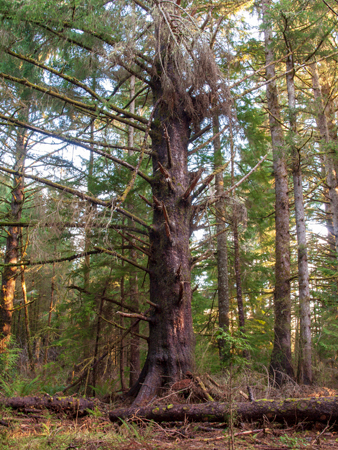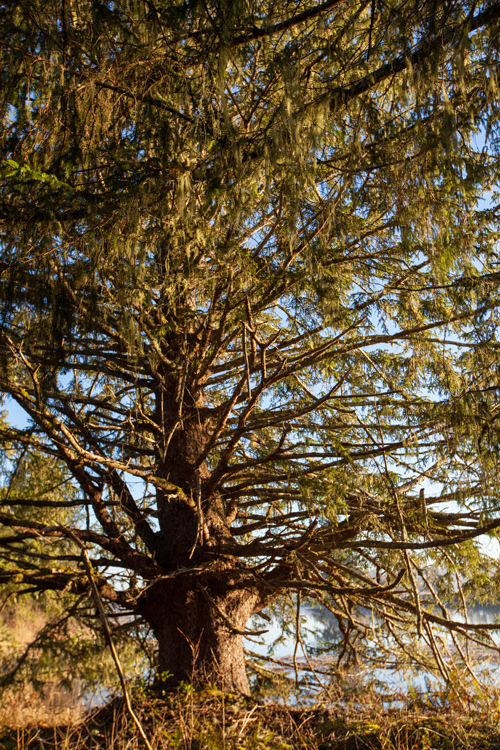Sitka spruce, Picea sitchensis
Fort Clatsop
© 17 December 2010 by Kristopher K. Townsend. Permission to use granted under the Creative Commons Attribution-Share Alike 4.0 International license.
Sitka Spruce
In 1791 the Scottish naturalist Archibald Menzies, who accompanied Captain George Vancouver on his exploration of the Northwest Coast, made note of a tree that no botanist had seen before. Fifteen years later, on 10 March 1806, Meriwether Lewis wrote in his journal:
The hunters who were over the Netull the other day informed us that they measured a pine tree, (or fir No 1) [Sitka Spruce] which at the hight of a man’s breast was 42 feet in the girth about three feet higher, or as high as a tall man could reach, it was 40 feet in the girth which was about the circumpherence for at least 200 feet without a limb, and that it was very lofty above the commencement of the limbs. from the appearance of other trees of this speceis of fir and their account of this tree, I think it may be safely estimated at 300 feet. it had every appearance of being perfectly sound.
Twenty years later the Royal Horticultural Society of London sent the Scottish botanist David Douglas to the American Northwest. Douglas and his party anchored in Baker’s Bay on 7 April 1825:
they form one of the most striking and truly graceful objects in Nature. Those on the other hand which are in the dense gloomy forests, two thirds of which are composed of this species, are more than usually straight, the trunks being destitute of branches to the height of 100 to 140 feet, being in many places so close together they naturally prune themselves, and in the almost impenetrable parts where they stand at an average distance of five square feet, they frequently attain a greater height and do not exced even 18 inches in diameter close to the ground. In such places some arrive at a magnitude exceeded by few if any trees in the world generally 20 or 30 feet apart. The actual measurement of the largest was of the following dimensions: entire length 227 feet, 48 feet in circumference 3 feet above the ground, 7-1/2 feet in circumference 159 feet from the ground.
Some few even exceed that girth, but such trees do not carry their proportionate thickness to such a vast height as that above mentioned. Behind Fort George, near the confluence of the Columbia River, the old establishment of the Honourable the Hudson’s Bay Company, there stands a stump of this species which measures in circumference 48 feet, 3 feet above the ground, without its bark. The tree was burned down to give place to a more useful vegetable, namely potatos.
In the memorable journey of Lewis and Clarke (p. 455), in their interesting account of the timber of that country, we find that they “measured some 42 feet in circumference, at a point beyond the reach of an ordinary man. This trunk for the distance of two hundred feet was destitute of limbs; the tree was perfectly sound, and, at a moderate calculation its size may be estimated at three hundred feet.” I am most willing to bear testimony to the correctness of their statements as respects the girth of the timber, but after a two years’ residence, during which time I measured any tree that appeared from its magnitude as interesting, I was unable to find any from actual measurement exceeding the height I have mentioned.[1]The Journal Kept by David Douglas During his Travels in North America, 1823-1827 . . . (London: William Wesley & Son, 1914)
Sitka spruce occurs in scattered locations along the Pacific Coast from south-central Alaska to northern California. Although Lewis considered this to be the tallest tree, it grows only to about 80 m (262 ft) in height. Sitka spruce is the state tree for Alaska.
Western Hemlock, Tsuga heterophylla
‘Netul’ River, Fort Clatsop
© 21 January 2013 by Kristopher K. Townsend. Permission to use granted under the Creative Commons Attribution-Share Alike 4.0 International license.
Western Hemlock
Lewis described western hemlock on 5 February 1806 as follows:
Fir No. 2 is next in dignity in point of size. It is much the most common species, it may be sad to constitute at least one half of the timber in this neighbourhood. it appears to be of the spruce kind. it rises to the hight of 160 to 180 feet very commonly and is from 4 to 6 feet in diameter, very stright round and regularly tapering . . . . the bark is thin of a dark colour, and much divided with small longitudinal intersticies; that of the boughs and young trees is somewhat smoth but not so much so as the balsom fir [Abies balsamea (L.) Mill., balsam fir] nor that of the white pine [Pinus strobus L., eastern white pine] of our country. the wood is white throughout and reather soft but very tough, and difficult to rive. The trunk of this tree is a simple branching diffused stem and not prolifeorus as the pines & firs usially are but like most other trees it puts forth buds from the sides of the small boughs as well as their extremities . . . . the stem usually terminates in a very slender pointed top like the cedar. The leaves are petiolate, the footstalk small short and oppressed; acerose reather more than half a line in width and very unequal in length, the greatest length being little more than half an inch, while others intermixed on every part of the bough are not more than a 1/4 in length. flat with a small longitudinal channel in the upper disk which is of a deep green and glossey, while the under disk is of a whiteish green only; two ranked, obtusely pointed, soft and flexable . . . . this tree affords but little rosin. the cone is remarkably small not larger than the end of a man’s thumb soft, flexable and of an ovate form, produced at the ends of the small twigs.
Douglas confused this with eastern hemlock, T. canadensis (L.) Carr., a tree that gets only as far west of the Great Lakes region. The western hemlock is widespread along the coast and coastal ranges from Alaska to northern California and disjunct in the northern Rocky Mountains of British Columbia and Alberta southward into northeastern Washington, northern Idaho and northwestern Montana. The two species are similar, but it is interesting that Lewis–who certainly knew the eastern species–was able to distinguish the two without difficulty. Douglas, in his unpublished manuscript written in 1828 or 1829, considered the species to be abundant “on the woody parts of the North-West coast, fully larger than any found on the Atlantic side of the Continent from the 43° to the 49°; not in the interior nor in the valleys of the Rocky Mountains”[2]see App. VIII in Douglas’ Journal published in 1914.
Grand fir, Abies grandis
Upper Surface
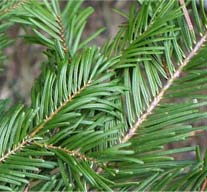
Underside

Grand Fir
This is a “true” fir—Abies (AYE-bees, Latin for “silver fir”) grandis (GRAND-iss, “grand”), commonly called “grand fir,” or “lowland white fir.”
Lewis remarked on it (6 February 1806) as:
a species of fir which one of my men informs me is precisely the same with that called the balsam fir of Canada. It grows here to considerable size, being from 2-1/2 to 4 feet in diameter and rises to the hight of eighty or an hundred feet . . . . This tree affords considerable quantities of a fine clear aromatic balsam in appearance and taste like the Canadian balsam.
In fact, grand firs 5 feet in diameter and 200 feet high are fairly common west of the Cascade Range. Balsam, or balm, is an aromatic resin that in Biblical times was believed to have potent medicinal properties.
Pacific Silver Fir
The Pacific silver fir is mainly a coastal species along the coast of southern Alaska and British Columbia, but is found primarily inland in the mountains of Washington and Oregon. There are scattered populations of Abies amabilis along the coast including sites near the mouth of the Columbia River in Clatsop County, Oregon (Little, 1971). However, given the paucity of the description, it is possible the tree Lewis had in mind is avdepauperate form of Abies grandis as suggested Piper (in Thwaites 1904, 4: 45) and Coues (1893, 3: 831). The suggestion by Moulton (1990: 284) that this might be A. amabilis can not be ignored, given the needle length provided by Lewis. However, as Moulton remaked, the bark features are much more akin to those of A. grandis than A. amabilis. Based on the overall set of limited features presented by Lewis, I am willing to suggest Lewis had the Pacific silver fir rather than a small grand fir.
Lewis described this fir on 6 February 1806 as follows:
(No. 4) is a species of fir which in point of size is much that of No. 2 [Tsuga heterophylla] . . . . the stem simple branching ascending and proliferous; the bark of a redish dark brown and thicker than that of No. 3 [Abies grandis] . . . . it is divided with small longitudinal interstices, but these are not so much ramifyed as in species No. 2. the leaves with rispect to their position in regard to each other is the same with the balsam fir [Abies balsamea (L.) Mill.], as is the leaf in every other rispect except that is not more than 2/3rd the width and a little more than half the length of the other, nor is it’s upper disk of so deep a green nor so glossey . . . . it affords no balsam and but little rosin . . . . the wood also white soft and reather porus tho’ tough.
Douglas-fir, Pseudotsuga menziesii

Dave Nelson photo.
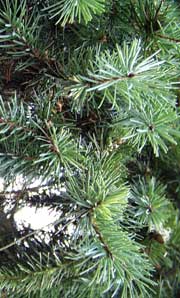
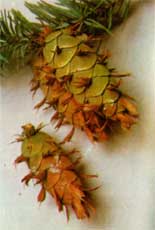
Douglas-fir
Given the bewildering variety of new plant and animal species before him on the west side of the Rockies, it is all the more remarkable that Lewis was so thorough, orderly, and accurate in his observations, collections, and record-keeping. For instance, he enumerated six different evergreen conifer trees in the neighborhood of Fort Clatsop, which he sought to “discribe as well as my slender botanicall skill will enable me.” He enumerated six of them, referring to all as “fir” trees.
“No. 5,” he wrote on 6 February 1806:
is a species of fir which arrives to the size of Nos. 2 [later, western hemlock] and 4 [possibly Pacific silver fir], the stem simple, branching, diffuse and proliferous. The bark thin, dark brown, much divided with small longitudinal interstices and sometimes scaleing off in thin rolling flakes. It affords but little rosin [pitch] and the wood is redish white 2/3ds of the diameter in the center, the ballance white, somewhat porus and tough. The twigs are much longer and more slender than in either of the other species. The leaves are acerose [needle-like], 1/20th of an inch in width, and an inch in length, sessile [without a stalk], inserted on all sides of the bough, streight, their extremities pointing obliquely toward the extremities of the bough and more thickly placed than in either of the other species; gibbous [convex] and flexeable but more stif than any except No. 1 [eventually named Sitka spruce, new to science] and more blontly pointed than either of the other species; the upper disk has a small longitudinal channel and is of a deep green tho’ not so glossy as the balsam fir. The under disk is of a pale green.
Lewis’s “No. 5” has come to own the name “Douglas-fir.”[3]For the whole story, the serious student of botany is referred to Discovery Path Douglas-fir: A Nomenclatural Morass by James Reveal.
It didn’t come with a name, this giant of the vegetable kingdom, and as a north coast logger might put it, that’s where the kerf grabs the blade. Botanists work from the proposition that if one studies the physiognomy, as it were, of a number of look-alikes, each will name itself according to the characteristics that mark it as a unique species, or subspecies. It’s seldom been that simple, and it’s often been temporary.
Douglas-fir trees on the Northwest coast can live 750 years or more, reach heights of over 200 feet, and diameters of 4 to 8 feet. Its wood is of prime importance for building purposes, and especially for the manufacture of plywood.
Douglas Fir or Douglas-fir?
Three days later, on 9 February 1806, Lewis found more to say:
In the marshy ground frequently overflown by the tides there grows a species of fir which I take to be the same [as] No. 5 which it resembles in every particular except that it is more defusely [irregularly] branched and not so large, being seldom more than 30 feet high and 18 inches or 2 feet in diameter. It’s being more defusely branched may proceed from it’s open situation, seldom growing very close. The cone is 2-1/2 inches in length and 3-3/4 in it’s greatest circumpherence, which is near it’s base, and from which it tapers regularly to a point. It is formed of imbricated [overlapping] scales of a bluntly rounded form, thin, not very firm, and smooth. A thin leaf is inserted into the pith of the cone, which overlays the center of and extends 1/2 an inch beyond the point of each scale.
In 1790, Archibald Menzies, a Scottish physician and naturalist, was appointed by the British government to accompany Captain George Vancouver on a global tour in the good ship Discovery. His main responsibility was to observe and describe the plants at the places he visited, record their scientific as well as Indian names, and note whether English settlers might be able to thrive in each place as farmers. On Vancouver Island, now part of the province of British Columbia, he made passing note of a tree that was new to him—the same one Lewis was to examine more closely 16 years later.
The tree still didn’t have a name when the Royal Horticultureal Society of London sent another Scotsman, David Douglas, to the American Northwest. Douglas and his party anchored in Baker’s Bay on 17 April 1825. It was about to get a name of its own, borrowed from Douglas. It was still viewed as a pine—”Oregon pine,” some called it—although its needles grow singly rather than in clusters, and its cones are quite different from a pine’s. Moreover, it shares certain characteristics with the species known as fir (in Latin, Abies, AY-beez), as well as with the spruce (Picea, PIE-see-uh) and the yew (Taxus, TAX-us). The Scottish-American naturalist John Muir dubbed it “Douglas spruce,” but some of his contemporaries thought it was a hemlock.
In 1867, new discoveries in China and Japan led to a compromise, and the name Pseudotsuga (SOO-doh-TSOO-ga), meaning “false hemlock,” plus douglasii in honor of David Douglas. That name was soon replaced by Pseudotsuga taxifolia, meaning “false hemlock with leaves like a yew.” Then, appealing to a technicality in botanical naming procedure, another botanist proposed Pseudotsuga menzesii (men-ZEE-see-eye), because Archibald Menzies got there first.
Nearly two hundred years’ worth of disagreements notwithstanding, the accepted common name in English today is properly written as Douglas-fir, the hyphen somehow diminishing the responsibility of the second noun, even if only to the eye.[4]Ibid. More common still is the name that brings to mind a living-room-sized pyramidal plant with a dense foliage of green leaves—all right, then, “needles”—and above all a heady, resinous aroma that spells . . . “Christmas tree!”[5]There’s one more: Poetically, Tann is the German word for “pine forest.” More specifically, it means “fir.” Baum is German for “tree.” So a Tannenbaum is a … Continue reading
References
Stephen F. Arno, Northwest Trees (Seattle: The Mountaineers, 1977), pp. 67-74, 92-97.
Elbert Little, National Audubon Society Field Guide to North American Trees, Western Region (New York: Knopf, 1980), plate 39; p. 252.
Notes
| ↑1 | The Journal Kept by David Douglas During his Travels in North America, 1823-1827 . . . (London: William Wesley & Son, 1914) |
|---|---|
| ↑2 | see App. VIII in Douglas’ Journal published in 1914. |
| ↑3 | For the whole story, the serious student of botany is referred to Discovery Path Douglas-fir: A Nomenclatural Morass by James Reveal. |
| ↑4 | Ibid. |
| ↑5 | There’s one more: Poetically, Tann is the German word for “pine forest.” More specifically, it means “fir.” Baum is German for “tree.” So a Tannenbaum is a “fir tree.” No hyphen! |
